The Zero-Party Data Playbook
In this playbook, you’ll learn how to collect, use and protect your customers’ zero-party data while delivering personalized buying experiences.
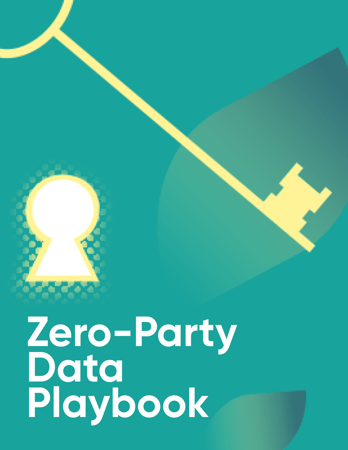
Sections
Playbook Overview
Customers are way more privacy-conscious than before. They don't want to feel like they're being stalked around the web by your (well-meant) digital ads just because they visited your site once.
There's a desire to move away from sneaky data collection and bad marketing practices. It's something major players are backing too, with recent changes to Apple's iOS giving users more ways to limit third-party data collection.
People are happy to share, but only when there's a good enough reason to — and on their terms.
The future of startups:
— GREG ISENBERG (@gregisenberg) May 1, 2021
- Privacy-first
- Community-first
- Sustainability-first
- Creator-first
- Decentralized-first
- Digital-first
Bookmark this list. Print it out
This is where the world is going
Zero-party data is the future.
It's privacy-first, community-first and sustainability-first.
It sidesteps customers' concerns over privacy, being tracked, and losing control of their personal data. Instead, zero-party data empowers customers and gives them the choice to share their closely guarded data with you — willingly and explicitly.
What You’ll Learn
How to leverage zero-party data as a marketing tactic to help you grow organically.
Together we’ll cover:
-
What is zero-party data?
-
Why it’s the future of eCommerce growth
-
Actionable (and fun) ways to collect zero-party data today
-
How to protect your customers’ personal data
Who Should Read This?
Looking for a more sustainable way to scale using personalized eCommerce experiences? This playbook is for you.
You might be:
-
Shopify or eCommerce business owner
-
An agency that specializes in eCommerce
-
A freelance developer, marketer, or consultant
What is Zero-Party Data?
Maybe they’ve signed up to your newsletter for a sweet promo discount or given you their mailing address to order a product.
It’s data that they’ve given you for a purpose.

Zero-party data is data that's given to you, directly and intentionally, by the user.
Some of the most common types of zero-party data you’ll see include email addresses, mailing addresses, and phone numbers.
These are the kinds of data you’d expect to provide when setting up an account, placing an online order, or joining an email list.
Examples of Zero-Party Data:
-
Email address, mailing address and phone number
-
Age, gender, budget, dietary requirements, life goals
-
Favorite colors, patterns, and styles
-
Skin type, skincare routine, preferred products
-
Favorite types of video games, movie genres, sports teams
-
Locations travelled to, vacation budget, nearest airport, hotel preferences
All this data is so valuable in the right context.
Knowing someone’s budget and how they travel can help you suggest the perfect products if you sell luggage.
If you’re a skincare brand, you can sell a personalized skincare subscription based on your customer’s own unique needs.
Zero-party data takes you away from bland and generic and makes your interactions with customers highly customized and relevant.
What Makes Zero-Party Data Different?
It's volunteered
Zero-party data is given explicitly. Your customer chose to give you their information, like an email address, in exchange for a discount or another incentive. It’s a win-win situation.
It’s valuable
Zero-party data is high quality and meaningful — with someone’s contact details and preferences, you can quickly build a strong customer relationship. In fact, 80% of consumers are more likely to buy when brands offer a personalized experience. It’s also inexpensive — you don’t need to buy data from another party to make things happen.
It’s reliable
Zero-party data is reliable and trustworthy, as it’s coming straight from the source—making you look like a pro. Meaning you don’t need to worry about accidentally upsetting a customer with the wrong suggestions or getting someone’s name wrong entirely.
Other Types of Data
As well as zero-party data, you’ll probably have come across other types of data. First-party, second-party, and third-party data can all play a part in a brand’s marketing strategy. These traditional types of data are more widely used than zero-party, but that’s all about to change.
First-Party Data 💻
First-party data is often collected by you without the customer being active in the transaction. If they haven’t read your privacy policy, they probably don’t even know it’s happening. Creepy, right?
Examples of first-party data:
- Online store browsing habits
- Email opens and link clicks from an email campaign
- Number of purchases made over a given time
First party data is useful, but can be hard to come by. You’ll probably need to combine it with other types of data to make your ad campaigns more effective, or optimize your website for more sales.
Second-Party Data 🤝
Second-party data is first-party data that was collected by someone else, that you’re now re-using in your business. Second-party data is usually bought because it can be used to help you optimize your own marketing campaigns, or gain useful insights into individuals that might be interested in your products or services.
Examples of second-party data:
- Buying a list of email addresses of users with a similar profile to your target audience from a non-competing brand
- Using a tech brand’s customer data to help you find a new audience for your tech accessories line
Second-party data can help you reach new audiences, but its usefulness is limited by the quality and amount of data you’ve bought.
Third-Party Data 🌐
Third-party data is the type of data that’s furthest away from being linked to an individual directly. It’s more generic, which makes it less valuable and harder to make an impact with.
Examples of third-party data:
- Someone browses an online clothing store for shoes
- They then visit a luxury watch website and make a purchase
- After this, they head to another site to watch videos about a new high-end vehicle
- A third-party data provider collects all these signals and uses them to form a picture of the user
- This third-party data is then sold to other organizations that want to target someone with a similar spending profile or interests
Third-party data comes from organizations that don’t have a direct relationship with the user — like an ad network. It’s aggregated and based on user behaviors and interests. While this helps you create an audience segment to target for digital ad campaigns, other uses are limited.
Why Zero-Party Data is Futureproof
There’s a major reason why zero-party data marketing works — it’s aligned with our customers’ views on the world. Let’s look at some of the trends that point to zero-party data as the future of eCommerce marketing.
User Tracking Is Out
Major changes are happening in the world of data privacy and app tracking. People are more aware than ever that brands watch what they do online, and there’s a growing movement to limit this.
People just don’t want to be internet-stalked. The data shows this, with 40% of people only consenting to mandatory cookies and 10% to none at all. This ‘tracking’ approach is on its way out.
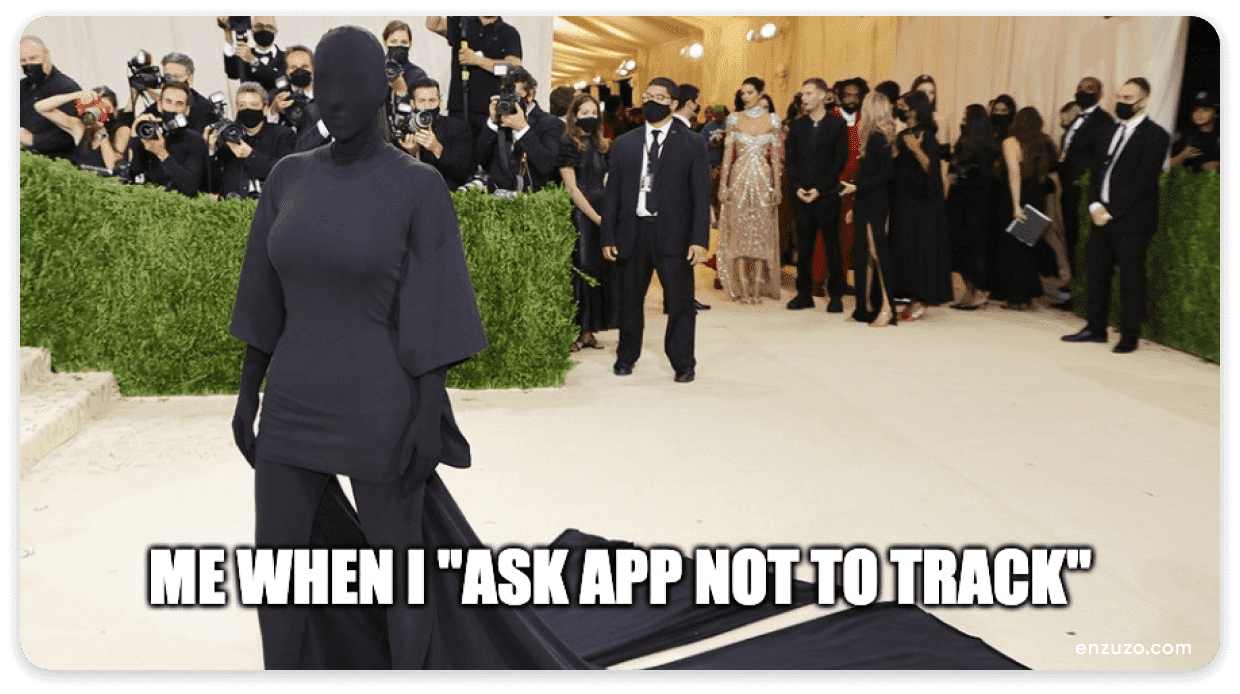
Data Transparency Is In
Apple’s iOS 14 introduced new limits on third-party data collection, and gave the power back to users to explicitly opt-in to data collection.
This hugely limits the opportunities to collect third-party data, making it even less impactful.
Apple’s upcoming iOS 15 release takes this a step further, as it introduces extra features like blocking a sender’s ability to see your IP address, or whether you’ve opened or interacted with an email.
A huge win for privacy, but a setback for data-hungry marketers.
Ad Spend is Skyrocketing
Right now, brands are spending big on digital advertising. Worldwide digital ad spend is at 378Bn US dollars, a figure set to rise to 646Bn by 2024. This is a big-money game, and a lack of third-party data is likely to make those digital ad campaigns less effective.
Unless marketers switch tactics, that is.
"...our overall marketing performance has declined by ~40% starting on Monday, 6/21 and continuing through today (6/28).
— Patrick Coddou (@soundslikecanoe) September 21, 2021
We are heavily reliant on FB, and the results we're seeing reported in-platform are very, very bad (CPAs skyrocketing up 100%+ what they were a month ago)."
Personalization Makes Retention Easy
To continue serving up relevant digital ads and reaching the right people, marketers need to make the move to a zero-party data-first approach. While some of us are worried about getting that data, research shows we don’t need to be.
83% of consumers are happy to share their personal data if it leads to a more personalized experience.
Building Brand Trust & Transparency
Before brands can make the most of the data they hold — and capture new data — they first need to earn customers’ trust. This can be tough, with 55% of people placing less trust in businesses they buy from than they used to.
That’s quite a mountain to climb.
Customers aren’t interested in being tracked and shown irrelevant advertising.
What they want is transparency, honesty, and control. In fact, 66% of consumers think transparency is one of a brand’s most attractive qualities. Embracing zero-party data puts transparency and data privacy at the heart of how you operate.
People like that.
7 Ways Brands Can Be More Transparent:
-
Make it easy for customers to request, delete or update their personal information
-
Make it easy to opt-out of marketing campaigns
-
Have clear policies outlined on your website (privacy, terms, cookie, do not sell my information, etc)
-
Go beyond the basics within your policies and share meaningful details (like how collecting your customer’s date of birth means you can send them a little birthday treat)
-
Send customers an email update when there are any major changes to privacy policies
-
Be proactive with any communications around mistakes or data breaches
-
Direct your customers to resources where they can learn more about data privacy
Making the switch to transparency is great business sense. If you gain your customers’ trust, you can unlock long-term loyalty. And this pays off, with the average customer spending 67% more in their third year with you than their first.
How to Collect Zero-Party Marketing Data
It’s great knowing you need zero-party data, but how do you collect it? And how do you do that in a way that creates a better experience for your customers?
Take a look at these better-than-average marketing tactics you can use to collect zero-party data.
Pop-ups to Capture Email and SMS
One of the easiest ways to collect zero-party data is with a pop-up to capture someone’s email address or phone number.
Most people are happy to hand over their email address to score a great discount, unlock a promotional offer, or receive super useful content.
Email popups are also a great way to grow your list. Expect to see new subscribers join you, the average conversion rate of email popups is close to 9%.
How to Create High-Converting Pop-Ups:
-
Consider what your audience wants — is it a discount, giveaway, free shipping, or access to exclusive content?
-
Design your visuals and copy to match your website and brand
-
Only collect the data you need — keep the fields to a minimum
-
Run A/B tests to figure out which version resonates best with your audience
-
Don't spam. Limit your pop-up behavior to show when the customer is most engaged.
TRY THIS TOOL:
.png)
Klaviyo: Email Marketing & SMS
Bring personalization and strategy to your email captures, with targeted forms, easy customization, and A/B testing.
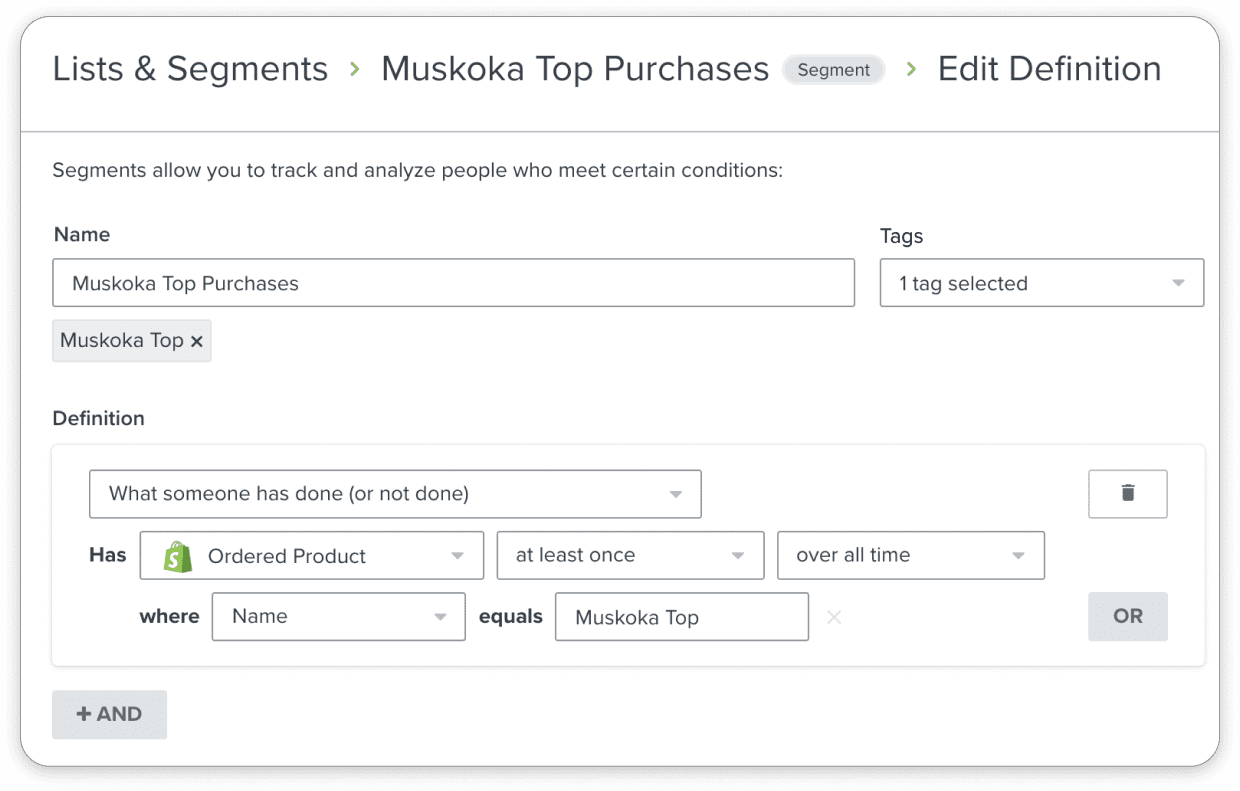
In Klavyio, it's easy to segment your email list by buyer behavior such as recent purchases or product type. You can also leverage the zero-party data collected like birthdates or locations to send targeted email campaigns that are more likely to convert because they're personalized to the customer.
For example:
An apparel brand that ships worldwide to both Canada and Australia might have completely segmented email campaigns due to the opposite climates of these two regions.
When it's winter in Canada, it's summer in Australia.
Therefore, the brand might want to promote different products via email for the appropriate climates (knit sweaters in Canada vs. tank tops in Australia).
Sending a generic campaign to the entire list would potentially be irrelevant to a large number of subscribers leading to poorer performance.
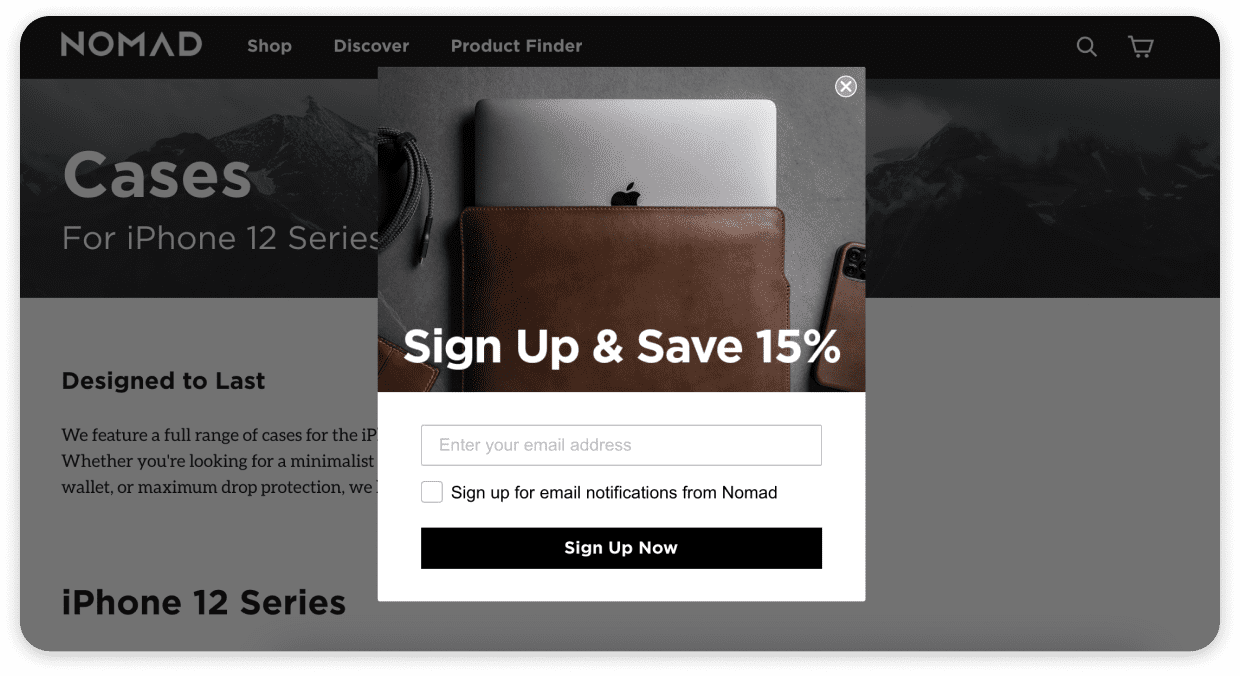
Example: Nomad
“Consider doing two different welcome series: One for people who sign up on the footer of your website, and another for people who sign up from social traffic. Give them entirely different content that’s more educational and focused on your brand.” — Chuck Melber, Marketing Director, Nomad
Interactive Social Media Story
These days, sponsored content on social media is a must-have. Running sponsored Instagram stories via the Ads Manager is a useful way to gather data and insights.
Out front, your customers get the fun feedback of taking part in a story poll. In the back end, you get useful data that you can use to personalize that customer’s experience in the future.
This is also a fun way to encourage your audience to stop by your website and shop — 50% of people have done just that after seeing it in Stories.
Creating Interactive Instagram Story Ads
-
Set up a new Instagram Stories campaign within Facebook’s Ads Manager and add an interactive poll
-
Design a poll that gives you answers on your customer’s preferences about something relevant — like a color, pattern, feature, or product
-
Test out the poll sticker sizing and location to make sure it looks great
-
Run your Instagram Stories ad to select groups to pick up relevant data
-
Use your new zero-party data for personalization, retargeting, and optimization.
TRY THIS TOOL:

Storypop Instafeed & Stories
Display your amazing Instagram Stories content on your Shopify store, like showing influencer reviews and product feature videos alongside your product pages.
Product Recommendation Quiz
Sometimes we’re just faced with too many choices when it comes to products. That’s especially true for cosmetics, skincare, and clothing.
Adding a profiling quiz to your website means you can offer a better customer experience with product recommendations — plus you gain their trust, and their email address. It’s a creative way to capture zero-party data.
How to Create a High-Converting Quiz:
-
Choose a product range or type to build your quiz around — e.g. concealer, perfume, or coffee beans
-
Feature questions that uncover someone’s preferences or needs, like skin type, favorite scents, or how they like to prepare their coffee
-
Map out the answers to these questions to direct someone to their personalized product recommendation
TRY THIS TOOL:

Octane AI: Shop Quiz
Greet visitors with a Conversational Pop-up or Shop Quiz to learn about needs while collecting opt-ins AND zero-party data.
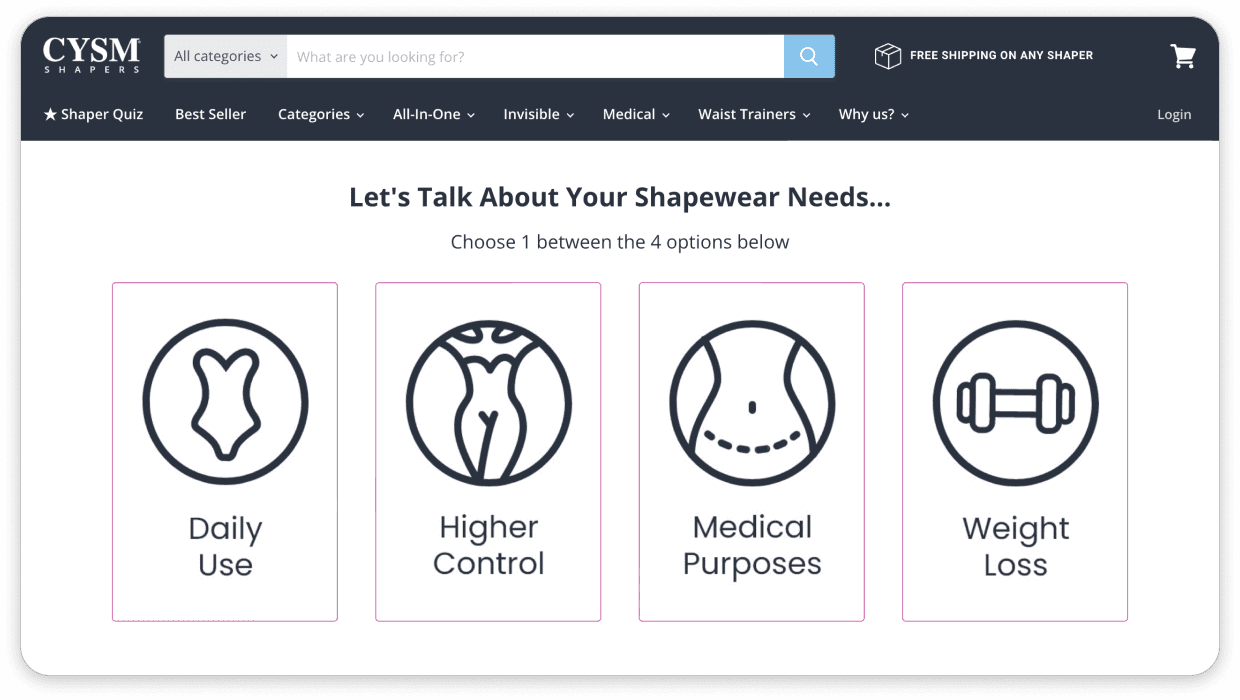
Example: CYSM Shapers
CYSM Shapers uses Octane AI's Shop Quiz feature to help recommend personalized products to their customers.
Skip the searching and get straight to selling. This data helps in a few ways — information to help CYSM understand their customers, producing products they want and for the correct use cases.
Also, they can use this data with their Facebook Pixel to deliver targeted marketing campaigns like specific ads based on their needs or segmented email campaigns.
Highly targeted ads = better ROI on ad spend. It's that simple.
"Thousands of merchants today collect high-value data directly from shoppers via our Shop Quiz and Conversational Pop-ups. They leverage that data across marketing channels like their website, email, ads, SMS and Facebook Messenger to improve the customer journey with personalization. We believe personalized interactions at every stage of the customer journey — powered by zero-party data — are the key to higher conversion rates."
EDWARD GAUG
Partnerships & Demand Gen Manager, Octane AI
User Generated Content (UGC)
While you already have the data on customer buying habits, user reviews and user-generated content give you extra insights into what they love about a product, how it’s used, and how excited they are to share about your brand.
Use this data to reward customers, optimize marketing campaigns, and create personalized experiences.
Ways to Capture Data from UGC:
-
Invite customers to share social media images with a hashtag, or user reviews, that appear on your website
-
Build a review or submission system that’s user friendly
-
Create a rewards or incentives system based on sharing valuable feedback, rating products, or sharing on social media.
TRY THIS TOOL:

Junip: Photo & Product Reviews
Junip makes it easy to collect and display dynamic, media-rich customer reviews from happy customers.
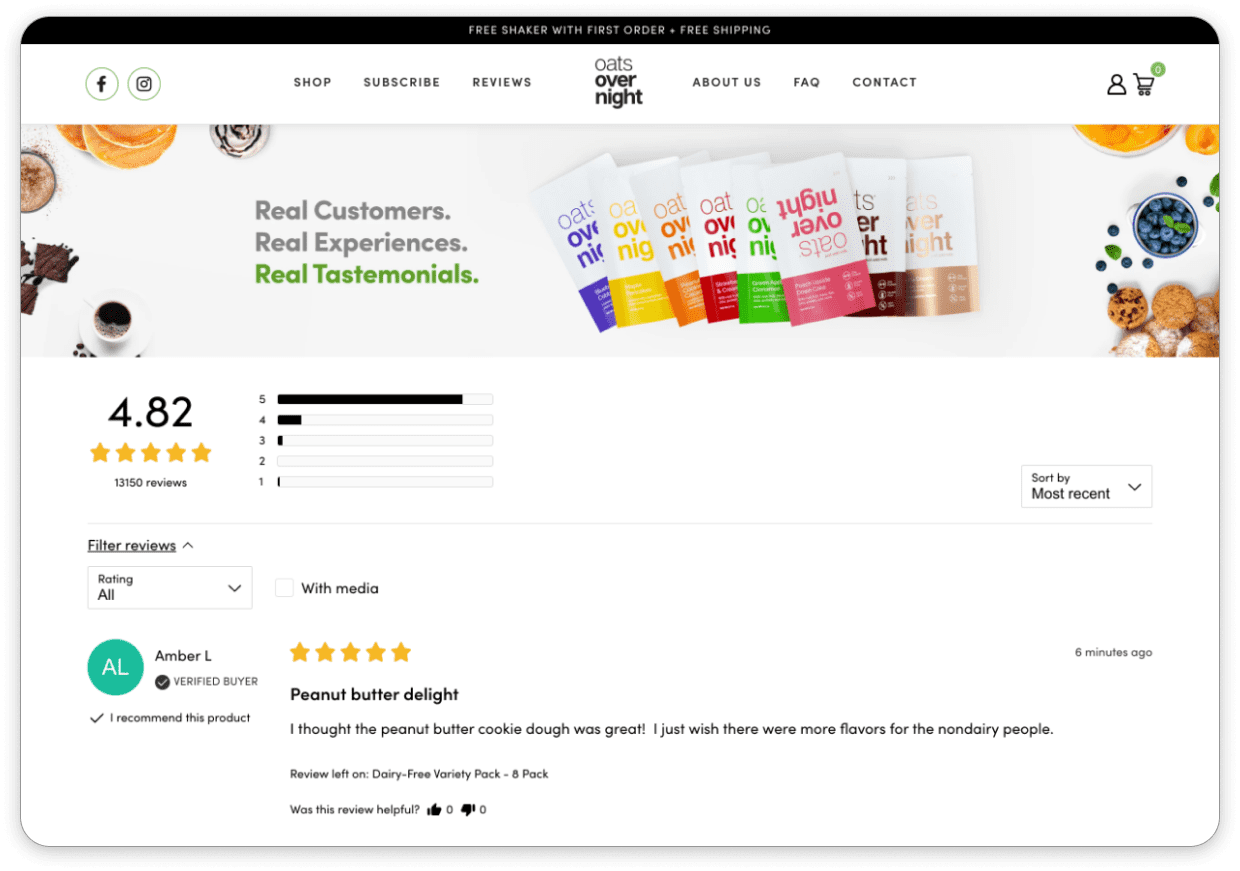
Example: Oats Overnight
Oats Overnight has leveraged product reviews in order to attract and convert new customers. They have a dedicated reviews page linked in their top navigation for customers to easily access.
"Brands of all sizes rely on product reviews as a way to capture zero-party UGC from their customers. Not only do brands leverage this content in their review section, but it’s also the solution for collecting organic UGC from customers to use across other marketing channels.
This creates social proof for your products and boosts conversions. Enabling brands to collect authentic UGC that other customers can trust is something we strongly stand by." — Leah Morrasut, Marketing Manager, Junip
As you can see in the image above, Oats Overnight can use direct customer feedback like "wish there were more options for non-dairy people" in order to make product development decisions among other things.
Post-Purchase Survey
We already know that the best people to give you data are your customers themselves.
Encourage your customers to give you the insights, feedback, and data you need by sending out surveys via email. Sure, you’ll need their email address first, but it’s a useful way to capture extra zero-party data. Make your surveys engaging and you could see response rates hit 85%+.
How to Create a Post-Purchase Survey:
-
Avoid overwhelm by focusing your survey on one area of feedback — e.g. shopping experience or new product lines
-
Give your customers an easy way to share data with star ratings, scales, and multiple-choice options
-
Automate where you can — e.g. ask for a rating or review a week after product purchase
TRY THIS TOOL:
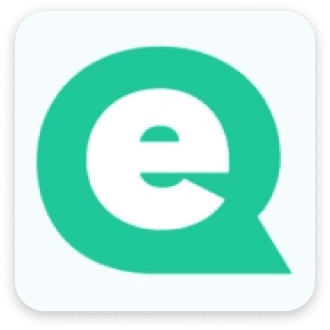
Enquire Post Purchase Survey
EnquireLabs allows you to ask your customers to complete a quick survey or question when they’re most engaged — right after they’ve made a purchase.
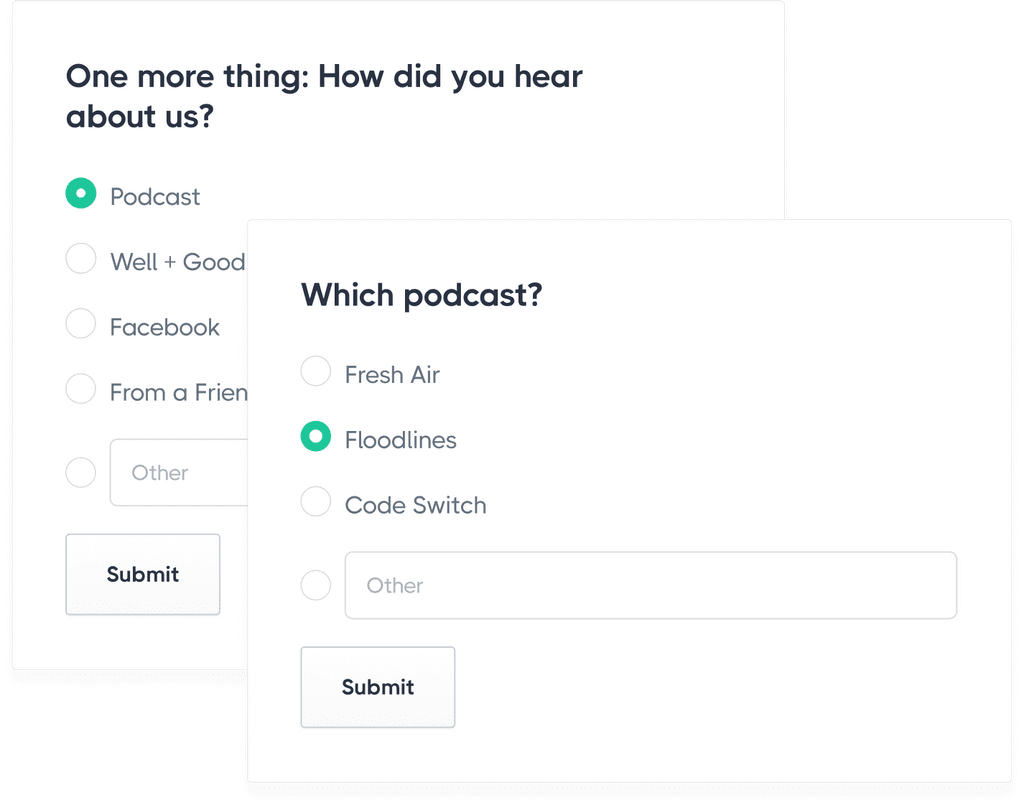
Knowing exactly where your customers come from helps you make a data-driven decision on what channels to focus your attention on.
Word-of-mouth? Create a referral program.
Podcast? Invest in more advertising.
Social media? Double-down on content.
Loyalty & Rewards Program
Loyalty programs are a great way to capture other types of zero-party data — like birthdates, product preferences, and lifestyle data. Customers are happy to share more with you because they benefit from your loyalty and reward program perks.
Make sure you create plenty of ways to earn points, as 38% of people get frustrated if buying a product is the only way to earn points.
Tips for an Effective Loyalty Program:
-
Ask your customers what they want to see most — is it discounts, VIP access, free products, or free shipping?
-
Decide which actions you want to reward with points, and set tiers to unlock perks and rewards
-
Create excitement around your loyalty program and incentives social shares to help promote it
-
Focus on building a strong brand community on a channel (Facebook, TikTok) where your customers spend time
TRY THIS TOOL:

Smile: Rewards & Loyalty
Easily create and launch a fun, engaging customer loyalty program where people can exchange points for rewards, refer friends or become a VIP.
.png)
Example: Béis Travel
Béis, a popular travel bag and accessories brand is doing loyalty and rewards right.
They sent a personalized SMS message to rewards members offering exciting perks.
Here's why it works:
It's Personal: SMS tends to feel more personal than email. Your brand should come across like a friend would — texting something interesting. In this case, Béis nails it.
It's Exclusive: Making the customer feel like they're a part of a community using language like "you're invited".
It's Attractive: The rewards member gets a discount and earns 3x points for every $1 spent which incentivizes them to purchase.Subscription Program
Subscription programs are such a great way to increase revenue, reduce churn, and improve customer loyalty. It’s benefits like these that influence trends, as 75% of direct-to-consumer businesses will offer subscriptions by 2023.
Knowing how often someone wants to buy your product doesn’t just help you cater to their needs — it helps you plan a personalized marketing cycle. It’s another way to use zero-party data to improve customer experience.
Tips on Launching a Subscription Program:
-
Set up a subscription program that lets your customers buy your product at regular intervals
-
Make it easy for someone to pause their subscription or change dates — instead of cancelling
-
Introduce add-ons, upsells, and additional product offers during the checkout
TRY THIS TOOL:
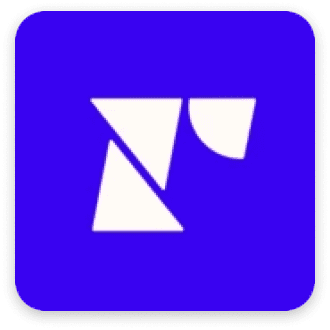
Recharge Subscriptions
Manage your subscription business within Recharge’s powerful merchant portal all while enabling your customers to fully manage their subscriptions directly from your store.
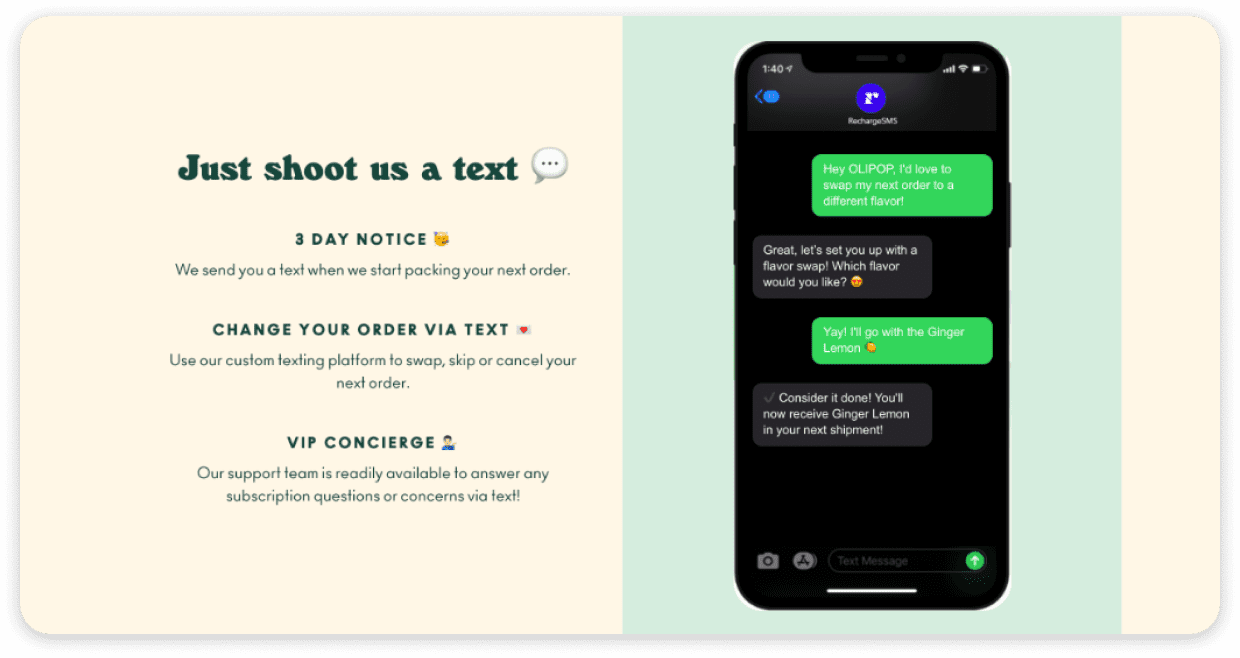
Example: Olipop
Drinking healthier is easy with OLIPOP, as they offer a subscription program for their delicious and unique cola alternative.
Each month, the customer can swap, skip, or cancel their order, which provides valuable customer data that can be used to improve or change the program for future signups based on previous behavior.
Brands on Recharge utilize subscription data along with other integration partners to combine and gain accurate, valuable insights about the performance of interactions with their brand. This allows merchants to create personalized shopping experiences for customers and open up new opportunities for subscribers, who are the most engaged loyal customers.
Gathering “direct from the consumer” zero-party data to better connect and understand them helps subscription merchants increase lifetime value and build community.
CALLIE HAWLEY
Senior Content Manager, Recharge Payments
Customer Profile or Account
Sometimes checking out as a guest makes sense, but for most of us, we appreciate saving our details, preferences, and credit card information for future purchases. In fact, 64% of shoppers are more likely to make a future purchase after they’ve set up an account.
With a customer account, you simplify the shopping experience — plus, you can collect some tasty zero-party data.
How to Make the Most of Customer Accounts:
-
Make it simple to create a customer account in just a few clicks
-
Collect the basics like name, email, and shipping address — with optional extra fields that give you insights into preferences and tastes
-
Give your customers the option to update their preferences in a fun way — like with an interactive quiz or survey
-
Integrate this with your loyalty program and reward customers for updating their preferences
-
Use the zero-party data you hold in customer accounts to suggest relevant products, send targeted marketing campaigns, and reward brand loyalty
TRY THIS TOOL:
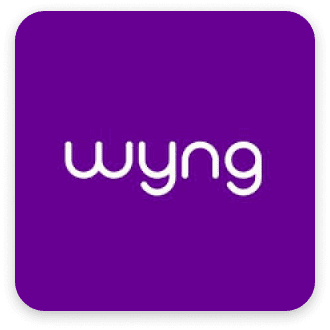
Wyng
Wyng helps you build better, more personalized customer profiles that your customers can enhance and update themselves.
.png)
The standard customer account on Shopify doesn't capture much data that can be used to personalize the online shopping experience.
In 2022, we expect customer accounts will level-up, and include insights like product preferences, sizing, and physical attributes that will help brands predict what their customers will want.
"Understand your customers better so that you can serve them better. That's the big opportunity with zero-party data." — Wendell Lansford, Co-Founder, Wyng
Contests or Sweepstakes
Who doesn’t love the idea of winning something for (almost) nothing?
Contests and sweepstakes entice your customers to share their zero-party data in exchange for a potential big win. This is a great way to collect a high volume of email addresses, and if you’re smart then other data too.
Here's How to Leverage Contests:
-
Design a sweepstakes or contest with a prize your ideal audience is highly interested in
-
Make it easy to submit an entry and collect only the data you need
-
Get free promotion by incentivizing sharing the contest on social media or with friends to gain extra chances to win
-
Introduce an optional survey or quiz — that collects additional zero-party data — as an additional way to win
TRY THIS TOOL:

Gleam Competitions
Gleam makes it easy for you to run contests and competitions with plenty of entry options, with a dedicated app designed for Shopify.
Conversational Messengers
Highly responsive customer support is a must-have for busy eCommerce stores these days.
Give your customers a way to find the answer or speak to an expert with a conversational business messenger or pop-up chat. This is a win for customer satisfaction and helps you capture zero-party data from potential and existing customers while they’re already engaged.
How to Use Conversational Messengers:
-
Add a conversational messenger to your website to support your service and sales teams to win over your prospects and customers
-
Make it easy for customers to share their name and email address to join or save a conversation with a bot or team member
-
Easily share links to surveys, newsletter signups, product quizzes, and more
TRY THIS TOOL:

DelightChat: Helpdesk & Live Chat
Deliver upbeat, personalized customer service to your Shopify store. DelightChat lets you reply to customers from multiple channels, use automated replies, and offer on-page live chat.
How to Use Zero-Party Data for Growth
Once you’ve collected your zero-party data, you can put it to work to help you drive growth, increase sales, and optimize your sales funnel through personalized marketing campaigns.
This personalization has a direct, positive impact on your profitability. Research shows that personalization can reduce acquisition costs by nearly 50%, lift revenue by 5-15%, and increase the efficiency of your marketing spend by 10-30%.
How’s that for impact?
This customized, personal approach to business is great for loyalty, too. Over 60% of consumers say they’d become repeat buyers after a personalized shopping experience.
Personalization helps customers see and buy more of what they want. With the data they’ve given you, you can tailor recommendations and make everything feel like a 5-star experience.
Ways to Personalize & Segment your Campaigns:
-
Send individual automated emails like a birthday discount or offer
-
Recommend personalized products based on the customers' previous order or quiz responses
-
Offer exclusive sales or early access to your most loyal customers
-
Throw a special event or promo based on your customers' location
-
Use the Facebook Pixel to send highly targeted ads to customers based on their behavior on your website
Personalization doesn’t just drive better results and more sales. It’s also a powerful way to build customer relationships. It doesn’t go unnoticed either, as 59% of shoppers that have experienced a personalized service say it has an influence when they shop.
This customized, personal approach to business is great for loyalty, too. Over 60% of consumers say they’d become repeat buyers after a personalized shopping experience.
Personalization helps customers see and buy more of what they want. With the data they’ve given you, you can tailor recommendations and make everything feel super personal.
Make Your Data Play Nicely Together
With advertising platforms no longer able to collect information without permission, the onus is on brands to start building direct relationships with customers, asking them for data, and syncing it across their eCommerce tech stack.
Alloy Automation allows brands to see the data collected from 100+ eCommerce apps and platforms in one place and send it across their tech stack with easy-to-set-up automation workflows.
KATIE KRISCHE
Marketing & Partnerships, Alloy Automation
Practice Safe Data
While customers are happy to hand over data for you to use in a relevant, personalized way, they’re still cautious when it comes to privacy. A recent study found 48% of global buyers stopped using a company or service due to privacy concerns.
It’s totally understandable.
Respect Personal Data
Brands need to be mindful of protecting zero-party data. It contains personally identifiable information, which is often covered by data privacy laws. That means it needs to be kept safe and treated with respect.
Data privacy should be at the heart of how you run your business now if you want to truly be transparent and gain your customers’ trust.
Stay Compliant With Privacy Laws
Be aware of and stay compliant with privacy laws that apply to your business. Visit our Learn Center for up-to-date articles on worldwide Privacy Laws.
Store data correctly, and make it easy for your customers to view the data you hold, make changes, or delete it.
Remove barriers where you can, and give your customers control and freedom over the data you hold on them. That’s the least we can do when we hold their personal data.
Our data privacy management platform lets you create and share a compliant privacy policy and terms of service, display a cookie consent banner, and manage your data requests all in one place.
TRY THIS TOOL:

Enzuzo: Data Privacy & Trust
Store compliance in minutes with laws like GDPR, CCPA, LGPD & PIPEDA. Add a custom cookie banner, and manage data requests, all in one place.
Backup Your Valuable Data
Now that you've collected all of this extremely valuable zero-party data, it's time to protect it. If one day it were to vanish, so might your eCommerce business.
Did you know that Shopify can't help recover your data?
Automatically backing up your store every day is crucial to protect both your data and your bottom line.
TRY THIS TOOL:

Rewind Backups
Rewind puts you in control of your data, allowing you to restore anything from a single image to an entire store.
Final Thoughts
The move towards zero-party data is happening, and it’s only a small part of a larger movement towards better data privacy for everyone.
Data privacy should be just as critical to you as which product lines you stock, or which marketing campaigns you run. Without trust and transparency, people aren’t going to give you that tasty zero-party data you need to see your eCommerce venture grow.